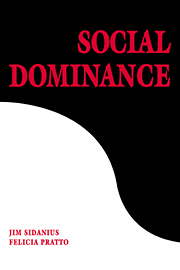Book contents
- Frontmatter
- Contents
- Acknowledgments
- Part I From There to Here: Theoretical Background
- Part II Oppression and Its Psycho-Ideological Elements
- Part III The Circle of Oppression: The Myriad Expressions of Institutional Discrimination
- 5 “You Stay in Your Part of Town, and I'll Stay in Mine”: Discrimination in the Housing and Retail Markets
- 6 “They're Just Too Lazy to Work”: Discrimination in the Labor Market
- 7 “They're Just Mentally and Physically Unfit”: Discrimination in Education and Health Care
- 8 “The More of Them' in Prison, the Better”: Institutional Terror, Social Control, and the Dynamics of the Criminal Justice System
- Part IV Oppression as a Cooperative Game
- Notes
- References
- Author Index
- Subject Index
7 - “They're Just Mentally and Physically Unfit”: Discrimination in Education and Health Care
Published online by Cambridge University Press: 05 June 2012
- Frontmatter
- Contents
- Acknowledgments
- Part I From There to Here: Theoretical Background
- Part II Oppression and Its Psycho-Ideological Elements
- Part III The Circle of Oppression: The Myriad Expressions of Institutional Discrimination
- 5 “You Stay in Your Part of Town, and I'll Stay in Mine”: Discrimination in the Housing and Retail Markets
- 6 “They're Just Too Lazy to Work”: Discrimination in the Labor Market
- 7 “They're Just Mentally and Physically Unfit”: Discrimination in Education and Health Care
- 8 “The More of Them' in Prison, the Better”: Institutional Terror, Social Control, and the Dynamics of the Criminal Justice System
- Part IV Oppression as a Cooperative Game
- Notes
- References
- Author Index
- Subject Index
Summary
Despite the fact that a very large proportion of both dominants and subordinates are convinced that both groups are treated equally within the domains of education and health care, the evidence we review next shows these beliefs to be significantly out of touch with reality.
Discrimination in Education
Confucius (551–479 B.C.), a sage and high-level bureaucrat, was one of the earliest documented examples of a poor person rising to fame and prominence by virtue of fortuitous access to higher education. In many hierarchical societies, education has been a key element in social mobility. Because of their power and value as scarce resources, education and literacy have tended to be reserved exclusively for ruling elites and their agents for most of human history. For example, many slave states in the United States made it illegal to teach slaves to read.
Mass literacy did not begin to emerge until around A.D. 1000 in Europe, and even then wa6s largely restricted to the ruling elites out of a fear of what impact it might have on the general social order. To the extent that subordinates were given literacy instruction at all, this instruction stressed rote memorization, rather than the ability to process information critically. It was not until the Industrial Revolution of the nineteenth century that basic literacy was extended to broad sections of the population. Though the twentieth century has seen an even further extension of literacy, this training still tends to be rather rudimentary and to stress rote learning rather than critical reasoning abilities.
- Type
- Chapter
- Information
- Social DominanceAn Intergroup Theory of Social Hierarchy and Oppression, pp. 178 - 201Publisher: Cambridge University PressPrint publication year: 1999



